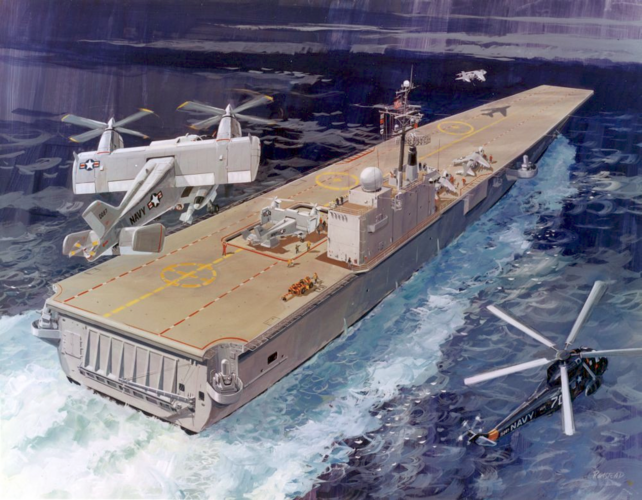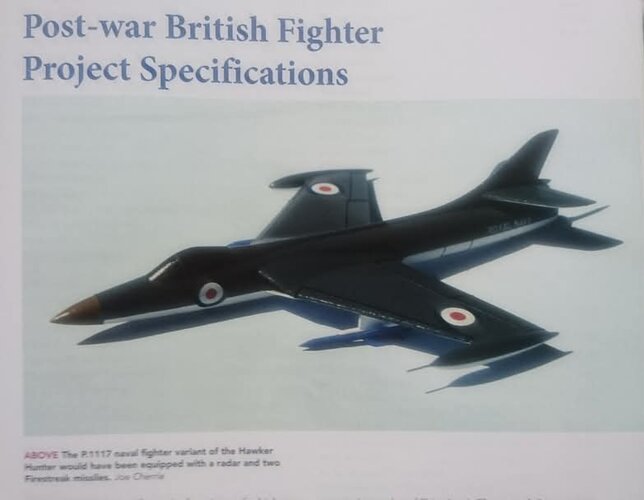Folded length and wingspan of certain naval aircraft.
- 42ft 11in x 27ft 05in - A-4E Skyhawk (its wings didn't fold).
- 47ft 03in x 25ft 07in - Etendard IVM.
- 35ft 03in x 23ft 00in - Sea Venom FAW.53.
- 34ft 08in x 16ft 01in - Sea Fury FB.11.
- 37ft 11in x 13ft 06in - Firefly AS.6.
- 37ft 04in x 13ft 04in - Navalised Hakwer P.1081.
- 39ft 10in x 13ft 04in - Sea Hawk FGA.6.
- 45ft 11in x 11ft 10in - Sea Hunter derived from Hunter F.6.
- 48ft 11in x 11ft 10in - Sea Hunter derived from Hunter T.7
Therefore, the Sea Hunter is:
- Somewhat longer than the Sea Venom, but its folded wingspan was considerably narrower;
- A bit longer than the Skyhawk, but it's folded wingspan is a lot narrower.
- About the same length as an Etendard, but its folded wingspan is a lot narrower.
The hangar of a Majestic class aircraft carrier was 52ft wide. Therefore, it aught to be possible to stow Sea Hunters four-abreast, compared to three abreast for the Firefly, Sea Fury & Sea Hawk, two-breast for the Sea Venom and one-abreast for the Etendard and Skyhawk. It aught to make deck parking easier. However, some of what the Sea Hunter gains by being narrower is lost by being longer.
This is why I've been saying that Melbourne could have carried 50-to-100% more Sea Hunters than Sea Venoms and 100% more Sea Hunters than Skyhawks. As you've mentioned the Etendard, it looks like Melbourne could have carried 100% more Sea Hunters than Etendards.
How I worked it out.
- The lengths for both Sea Hunters were 10½ inches, which I rounded up to the nearest inch to make the list easier to read.
- The folded length of the Sea Hunter is an estimate made by measuring the line drawing of the Hunter F.6 on Page 382 of my copy of Putnams "RAF Aircraft since 1918", which is the eighth edition published in 1988.
- I think (that in common with the Sea Hawk) the wings of the Sea Hunter would have folded at the wing roots.
- And from the drawing it looks like the wings would fold within the span of the tailplane.
- According to my measurements the wingspan was 57mm and the span of the tailplane was 20mm.
- Therefore - (33ft 8in ÷ 57) x 20 = 11ft 10in.
Which is narrower than I expected, because I thought that the answer was about 12ft 6in when I did it before.
While I'm at it, these are the folded dimensions of some other naval aircraft.
- 37ft 11in x 13ft 06in - Firefly AS.6.
- 43ft 00in x 19ft 11in - Gannet AS.1
- 44ft 00in x 19ft 11in - Gannet AEW.3.
- 39ft 04in x 24ft 00in - Skyraider AEW.1
- 43ft 06in x 27ft 04in - S-2D Tracker.
Therefore, a Gannet's nearly the same length as a Tracker, but it's narrow enough to stow two-abreast in the hangar of a Majestic class aircraft carrier, whereas a Tracker can only be stowed one-abreast. Being nearly 7½ narrower will make it possible to store more in the deck park. Therefore, the question is, what can the Tracker do that the Gannet can't that justifies its larger size?


